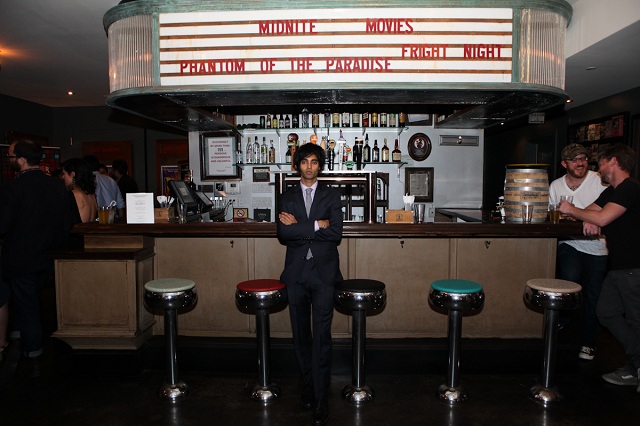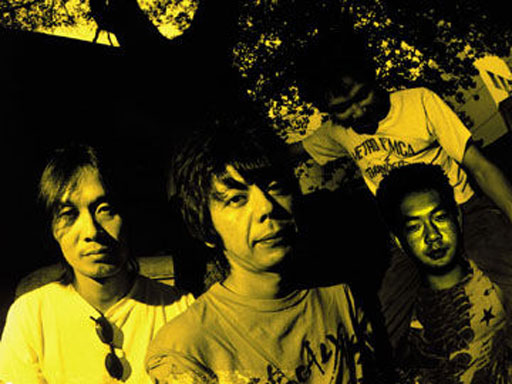Stereogum editor Amrit Singh has a hang with Das Racist hypeman Ashok Kondabolu. Proper nouns mentioned: George Washington, Britney Spears, Jenny Slate (a.k.a. the “Marcel the Shell” girl), and C. Mohan (Bollywood’s most iconic designer).

October 8, 2012
Did she get a lot of shit for that?
My family did. Yeah…
Relatives, probably.
Yeah. There’s a really sort of vibrant, catty Sikh community that my parents were a part of.
Do you remember what you were doing on 9/11 eleven years ago?
I was in law school in Madison, Wisconsin and I used to work out like crazy back then. It was one of my ways of escaping the crushing reality, the fact that I was in Madison, Wisconsin. Running, weight-lifting. I’d get up at 5 o’clock in the morning, run four miles, lift for an hour. I was like in crazy shape. (Chuckles.) But that was just one of those things. And um, they had this huge Gold’s Gym. They had these huge television screens, almost movie-projector-sized televisions in the gym; it was this massive complex. They used to show the morning shows (The Today Show, whatever) and—I saw smoke coming from the towers. They just had that on, but there was no sound in the gym.
Damn.
So I was like… That’s weird, some crazy fire. And then I watched the second plane go in, and uh—
And you’re like I gotta get the fuck outta here.
(Laughs.) I’m like, two more sets, and then I’ll go. No, I was out immediately. I went back to my apartment, went to classes; I had a lot of classes. My course load at that point was interesting with respect to a tragedy like that; I was doing a lot of international law. I was at the International Law Journal at the University of Wisconsin, Madison Law School, and so we were talking about it there, but very briefly that day, and I remember just walking out—they set up some security perimeter [around] the state capitol building, which looks exactly like the national capitol building.
Right, I was there recently on tour during Occupy Wall Street to see what was going on.
That town is a liberal, it’s a progressive city. Not that Wisconsin was such a backwards place—it’s actually a pretty progressive state. But at this point, they’d set up a security perimeter around the capitol building, and I was born in Queens, I’m a New York kid and, you know, moved out to Philly suburb when I was twelve, thirteen. And a lot of my life, from that point on when I moved to Philly, was all about this quest to get back to New York. I really felt like for a while the universe was trying to keep me from getting back to New York. I felt like I had to swim upstream to do it, and I arrived—obviously things have been great since—but I’ve always carried this pride of being a native New Yorker with me. Always. And on that day, it was inflamed, obviously. And I appreciate the need and concern to put a perimeter around a building like that, because no one knew exactly what was going on. But I had a sense of what was going on. And I had a sense that we were safe—
Yeah.
I got really upset actually at my classmates who hyper-localized it and really freaked out and I kind of [felt] like, we’re taking on an air of drama for the wrong reasons. Not in terms of the more global, broader conscious, but just in terms of the drama around what’s going on around the capitol building. And I had all my thoughts turned towards what was going on where something was actually going on. At a time when I was certain that people were just trying to get out of Manhattan, I was just wishing I could be getting there.

Yeah.
You know, I’ve been thinking about your art rap project. I’m always fascinated by the degree to which that catastrophe was figured into the origin story of Das Racist. And I mean, Hima’s so outspoken about a lot of that stuff. And he’s done a lot of writing and stuff, but do you feel like it’s been similarly impactful upon you?
I don’t think so. I mean, Himan seems to be a bit more weary of the post-9/11 South Asian racism and stuff like that. To be honest, some part of me kind of, not welcomed it, but when I saw somebody looking at me a certain way after that, I would want them to have said something, so I could beat them up, and it rarely ever happened. (Chuckles.)
(Laughs.)
And I would be disappointed by that.
So were you a physical kid? Would you actually start fights?
Not much at that point. I fought a lot between the ages of 18-20, and then I saw the Michael Hutchence Behind The Music, the INXS one, and he hit his head against something while getting into a fight with a cabbie and lost his sense of smell. After that I was like, Wow I could black out drunk, get into a fight that doesn’t matter, and wake up and not be able to smell. And maybe not remember why for the rest of my life, I can’t smell. That was one of the reasons I stopped. I also kept getting beaten up.
(Laughs.) Both good reasons. Yeah, you don’t wanna lose your sense of smell, ‘cause then you’d lose your sense of taste.
How did Stereogum start?
Stereogum absolutely started as a response to that place that has always written about Led Zeppelin. So like, Rolling Stone, Jann Wenner (fumbles with the name, then laughs). I think it’s probably a good thing that I don’t run in circles where people are just constantly dropping his name who actually know how to pronounce it. Old media heads, like Jann Wenner, just didn’t embrace the Internet. Rolling Stone didn’t really develop rollingstone.com until relatively recently, left a gaping void for sites like Pitchfork and ultimately, Stereogum.
Spin didn’t either.
Spin didn’t either, and this is what happens when these paradigm shifts come. You know, the ones who are entrenched and comfortable where they are don’t recognize when they’re coming. So that’s the story that gets played out with respect to Stereogum’s origin story. Scott Lapatine founded it. When Scott founded it, he was working at VH1, where he had a whole bunch of access to promo material working at VH1. He was also working on the digital side.
He started [it] in 2002, as a livejournal. And it was really calibrated to amuse his now-wife, as all great art stories go. It was to woo a girl. But he had a really fun and ultimately indie take on pop culture. He wrote a lot about Britney Spears, but in a way that took her down a peg in a fun way. But also celebrated what was sort of amazing about her. While also being like, I’ve got the new Interpol mp3, because nobody else knows how to rip shit. He just had an interest in things like Britney Spears and pop culture like that, and was very funny. He was the editor of the Cornell humor magazine, and he also had an interest in indie rock, always had—he’s a music geek. And he had digital smarts. So he developed this livejournal and was posting mp3s before labels needed to police them. And basically that combination of talking about indie rock, but also getting the amazing Google traffic that the Britney Spears content provided—he was one of the leading Britney Spears bloggers along with Perez Hilton and stuff—catapulted him to the front. He was one of the first mp3 blogs, but also became quickly one of the most trafficked culture blogs, and then he brought me on. I approached him.
How did you know him?
Um, I started a website—I moved to New York after law school to make music. I’m a musician by heart, I’m a frustrated musician, that’s what I do. I moved to New York to make music after taking the bar, sitting in my parents’ basement making music after law school. My dad was very fond of that decision.
(Chuckles.)
I got a job as a corporate attorney. I had no time to make music, but I had plenty of disposable income. And I had my nights, was seeing a lot of shows, and in searching about the new bands that I was learning about, going to like Bowery Presents shows or whatever, I discovered blogs. I discovered Stereogum, I discovered Brooklyn Vegan, I discovered basically a ’zine culture that moved to the Internet, and I was fascinated by it. I’d send links to friends along with my own reviews of shows as a way of sharing the amazing music scene that I felt I was discovering. And my friends were just like, you know, what you’re writing to us in an email is often superior to the things you’re linking to. You ought to consider starting a web site, which I think was both a means to encourage this new line of creativity for me, ‘cause they knew I was frustrated as an attorney, and also as a way for me to stop clogging people’s inboxes.
(Laughs.) Right.
And that’s the way it went. Honestly, I got extraordinarily lucky. I approached Scott at Stereogum with a review of Sufjan Stevens when I went to go see him at Lincoln Center—this thing that I wrote on a blog that I founded. I was living in the East Village at the time, so I called it Village Indian, and (chuckles) I posted a review to that. And he loved it, and he ran it. Then I went to—do you know that band the Editors?
Uh, barely.
They were just like a sort of second-rate post-punk band. Like, a derivative of Interpol, who are derivatives of Joy Division. So there’s like a third degree of separation from the source.
So it’s probably just alright, right?
(Laughs.) Monumental, monumental music. I was very proud to be participating in the culture of that moment. But I did write this review about it, and I sent it to Scott, and they were a buzzy band at the time. He had gone from wooing his now-wife to having married his now-wife, and was no longer going to shows and he was like, “This kid seems like he’s going to all the shows!”



